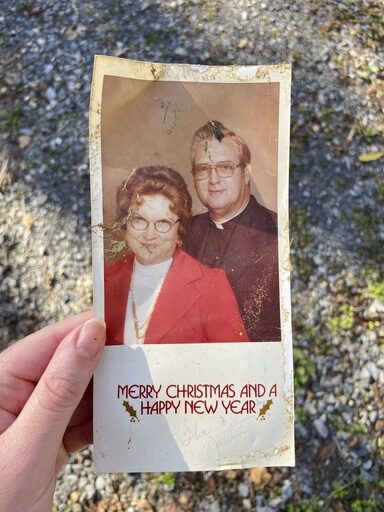
LOS ANGELES – In the aftermath of devastating storms and wildfires, communities are tirelessly working to reconnect people with their lost photographs, treasures that encapsulate memories of happier times. The scenes were grim: houses reduced to their foundations, vehicles buried in mud, and streets rendered desolate. For many, like Taylor Schenker, the destruction brought a rush of emotions.
After Hurricane Helene struck Asheville, North Carolina last September, Schenker found herself upset by the extensive damage showcased in images circulating online. “This storm has taken so much,” she reflected, noting how heart-wrenching it was to see the devastation surrounding families. Just days after the storm, she was determined to help those affected.
While searching through debris for a friend, Schenker unexpectedly stumbled upon a collection of mud-soaked snapshots. These photographs included vital moments from strangers’ lives—weddings, birthday celebrations, and cherished family memories, all caught in the grip of nature’s turmoil. “These tiny photos had been through so much, yet they emerged in a state where you could still recognize them,” the 27-year-old shared. This experience inspired her to create an Instagram account dedicated to reuniting people with their cherished images, aiming to replace despair with hope.
With the establishment of a post office box and collaboration with rescue volunteers, Schenker went on to recover over 500 photographs, which she affectionately termed “little needles in a haystack.” The feeling of success soared when she completed her first reunion. Overwhelmed with emotion, she found herself crying in her car.
Photographs serve as vital links to our past—moments that would otherwise fade into obscurity or be lost forever. To date, Schenker has successfully returned more than 70 images. One memorable delivery was made to Mary Moss, whose vehicle was devastated alongside their long-time home, a place where countless memories dwelled. “When she handed me those photos, it was overwhelmingly emotional,” said Moss. “You don’t expect something as fragile as photographs to be saved.”
Months after they lost their home, the family received some aid from FEMA and secured temporary accommodation where they gradually replaced lost possessions with community donations. However, some losses are irreplaceable. “This isn’t just about the house and the material things; it’s about what we lost that belonged to Tommy,” said Moss, reflecting on their son who passed away at twelve. “It’s the memories, the little things—photos you can never recreate.” Schenker commented on their fragile story, recognizing the bittersweet nature of their loss, stating, “They lost their home and, with it, most of their son’s existence.”
In similar circumstances, Claire Schwartz, 31, in Altadena, California, undertook a parallel mission of salvaging photographs following the Eaton fire. Alerted to the impending danger of rain damaging remnants of the fire, she took the initiative to start collecting lost images, storing them with preservation methods she learned during her time as an intern.
Schwartz noted the urgency in rescuing photographs given the swift onset of mold post-exposure to water. With proper conservation techniques such as freezing prints to minimize damage, she dived headfirst into her recovery mission. Schwartz’s endeavors led her to various locations searching for photos embedded alongside other sentimental items. “It’s bizarre how everything’s scattered and mixed with trash, making the search feel almost surreal,” she stated.
Although local libraries usually serve as repositories for discovered items, the Altadena Public Library unfortunately burned down, so librarians direct found photographs to Schwartz. Following her archival training, she meticulously protected each photo and designed a space where they could be preserved. Recently, she found success in matching lost images with their owners and experienced the emotional joy that comes with successfully reuniting people with their memories.
While Schwartz’s home remained intact due to the efforts of vigilant neighbors, the landscape around her reflected a profound transformation filled with signs of destruction. Meanwhile, Joshua Simpson, a local photographer who lost everything in the fires, also found solace in salvaging memories. “We found a beautiful vintage print of my mother-in-law holding my wife as a baby. It felt magical finding that amidst the chaos,” he communicated.
Emphasizing the importance of personal safety, experts like Luca Ackerman, who work with volunteer organizations, believe addressing emotional trauma is crucial during such recovery operations. People grappling with loss often respond with a spectrum of emotions, yet these disasters also enhance community bonds, showcased by the commitments of individuals like Schenker and Schwartz. “Situations like this truly bring out the best in humanity,” said Moss. “It’s essential to find humor amidst the sadness. We still have our lives, and that’s what matters most.”

